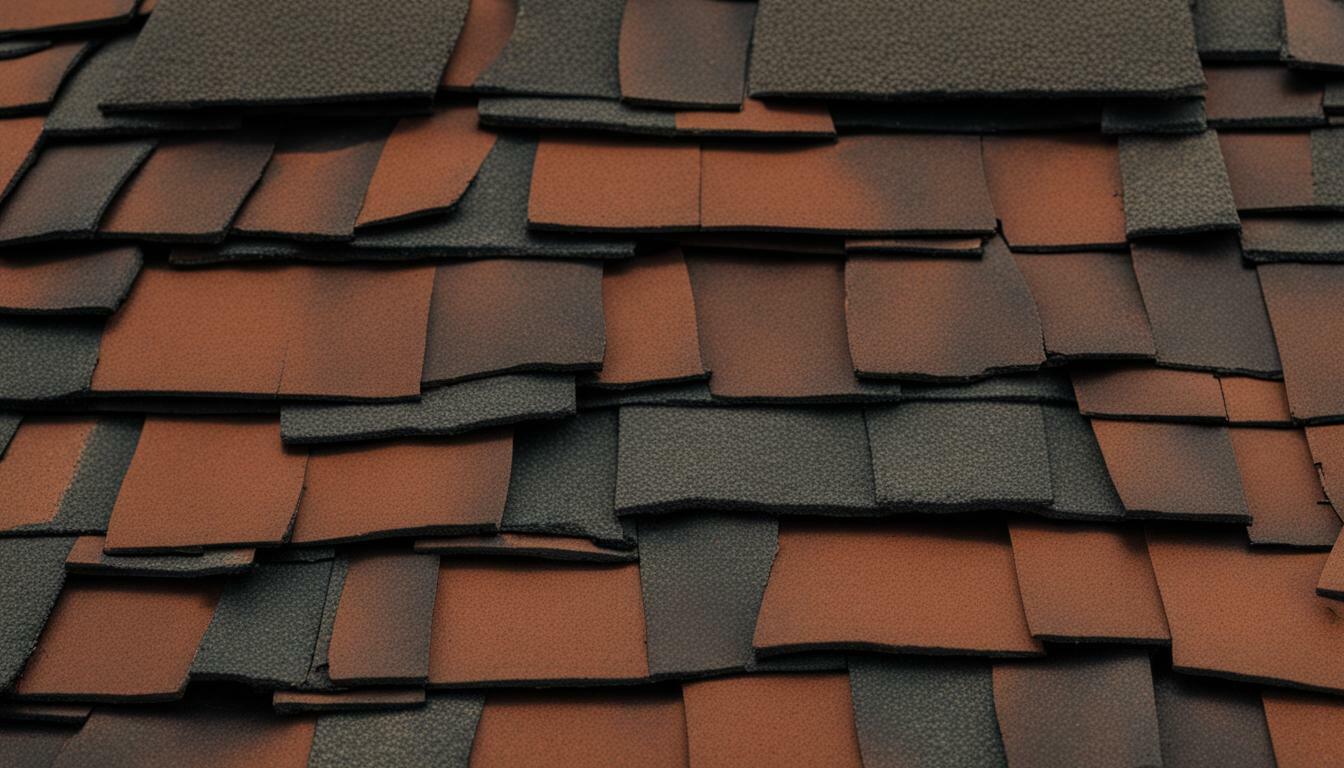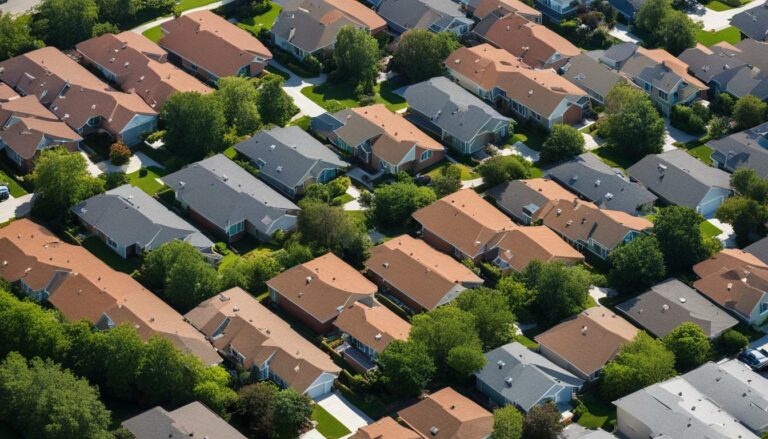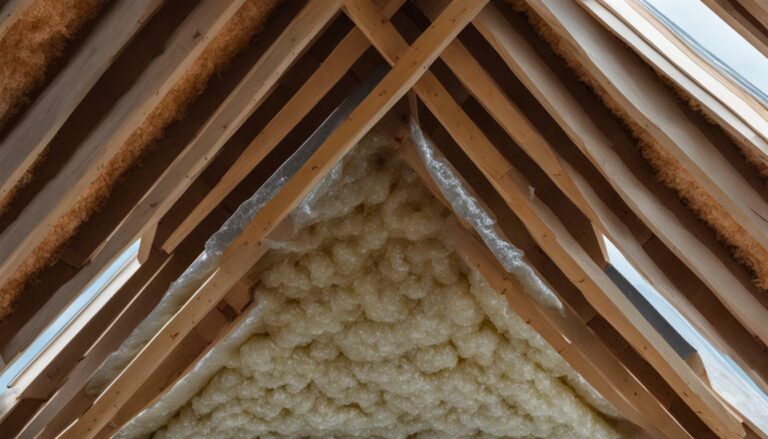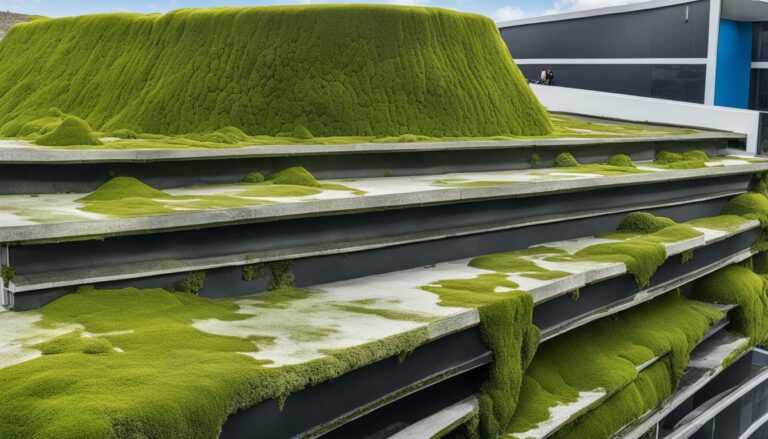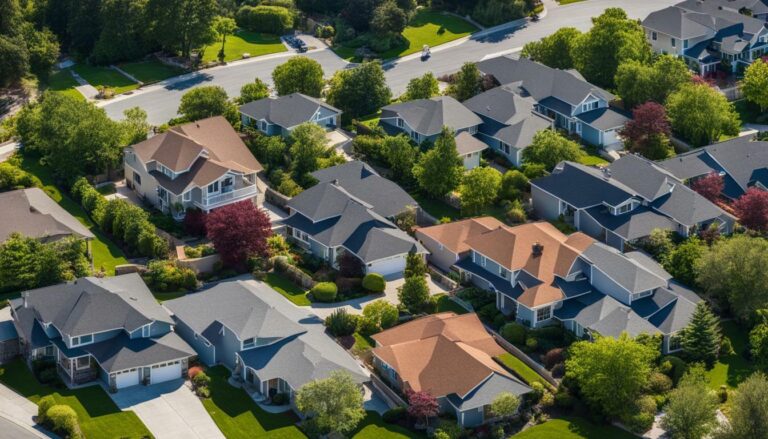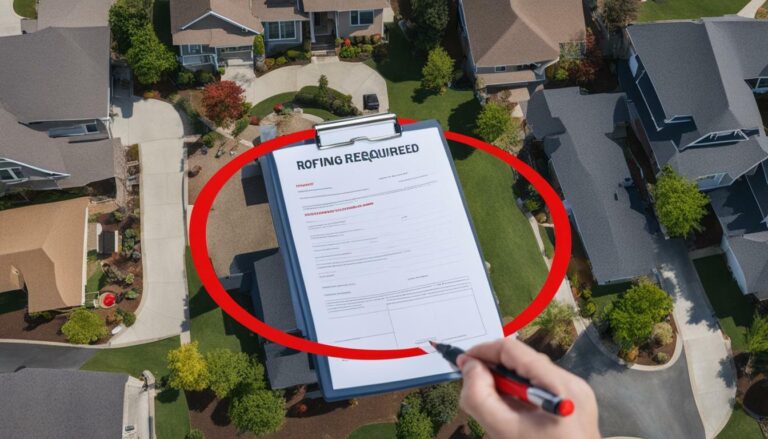Recognizing the Signs of a Damaged Roof: A Helpful Guide
Your roof plays a crucial role in protecting your home, and being able to recognize the signs of a damaged roof is essential for maintaining its lifespan and durability. Identifying these signs early on can help you avoid costly repairs and ensure the safety and integrity of your home.
There are several signs that indicate a damaged roof, including water stains in the attic, damaged or missing shingles, visible stains and spots on the ceiling, gutters filled with granules, a sagging roof deck, sunlight seeping through the roof, rising energy bills, compromised flashings and seals, problems with valleys, issues with chimneys and skylights, ice dams, and issues with roof accessories.
Key Takeaways:
- Recognizing signs of a damaged roof is crucial for avoiding costly repairs.
- Common signs include water stains in the attic, damaged or missing shingles, visible stains and spots on the ceiling, and gutters filled with granules.
- Other signs to look out for include a sagging roof deck, sunlight seeping through the roof, rising energy bills, compromised flashings and seals, and problems with valleys, chimneys, skylights, ice dams, and roof accessories.
- Regular inspections, prompt repairs, and preventive measures can help prolong the life of your roof.
- Seek professional advice if unsure about the condition of your roof.
Understanding Roof Lifespan and Durability
The lifespan of a roof can vary depending on various factors, such as the quality of materials used, installation techniques, climate conditions, and regular maintenance. Understanding these factors is crucial in determining the durability of your roof and ensuring its longevity.
On average, a well-maintained roof can last anywhere between 20 to 50 years. However, this lifespan can be significantly shorter if the roof is exposed to extreme weather conditions, such as heavy rain, snow, hail, or high winds. Additionally, poor-quality materials or improper installation can also reduce the lifespan of a roof.
To maximize the durability of your roof, it is essential to conduct regular inspections and address any signs of damage or wear immediately. This includes replacing damaged or missing shingles, fixing leaks, and reinforcing flashings and seals. Regular maintenance, such as cleaning gutters and removing debris, can also help prevent issues like clogged drains and water damage.
By taking proactive measures to maintain your roof, you can extend its lifespan and save yourself from costly repairs or premature replacement. Remember to consult with a professional roofing contractor for expert advice and guidance on maintaining the durability of your roof.
Table: Factors Affecting Roof Lifespan
| Factor | Impact |
|---|---|
| Quality of materials used | High-quality materials tend to be more durable and long-lasting. |
| Installation techniques | Poor installation can lead to premature roof failure. |
| Climate conditions | Extreme weather can cause accelerated deterioration. |
| Regular maintenance | Proactive maintenance can extend the lifespan of a roof. |
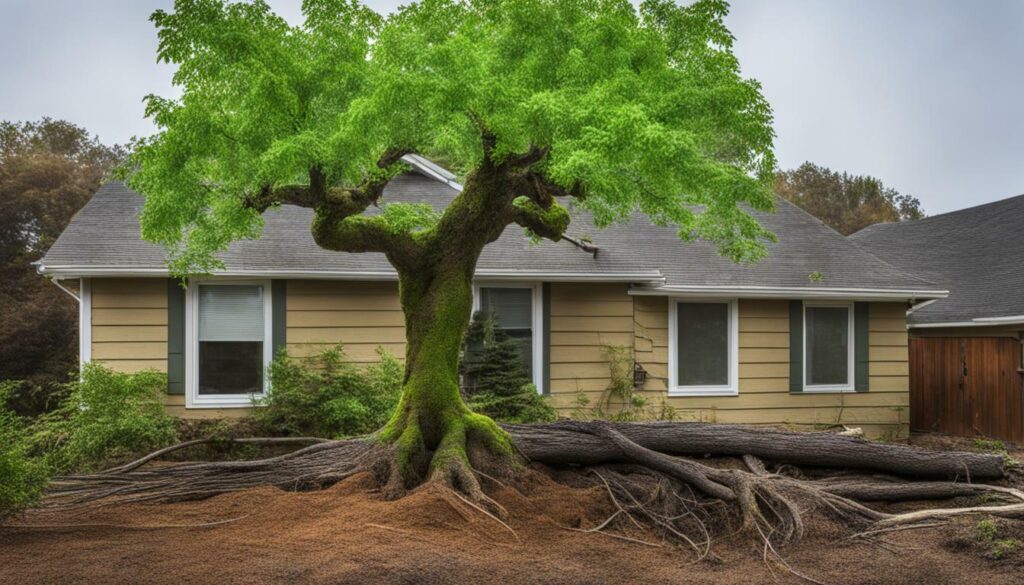
It’s important to remember that even with proper maintenance, all roofs will eventually wear out and require replacement. Regular inspections and prompt repairs can help prolong the life of your roof, but there will come a time when replacement is necessary. Consulting with a professional roofing contractor can help you determine when it’s time to consider a roof replacement.
- Keep an eye out for signs of roof damage, such as leaks, mold growth, or missing shingles.
- Address any issues promptly to prevent further damage and potential structural problems.
- Invest in quality materials and professional installation to ensure a durable and long-lasting roof.
- Regularly clean gutters and remove debris to prevent clogs and water buildup.
Common Signs of a Worn-Out Roof
Over time, a roof can show signs of wear and tear, indicating that it may be reaching the end of its lifespan. Recognizing these signs is crucial in order to prevent costly repairs and ensure the safety and integrity of your home. Here are some common signs that indicate a roof is worn out:
- Water stains in the attic: If you notice water stains or dampness in your attic, it could be a sign of a leaking roof. Pay attention to any discoloration or musty odors as well.
- Damage or missing shingles: Inspect your roof for any shingles that are cracked, curled, or missing. These issues can leave your roof vulnerable to leaks and further damage.
- Visible stains and spots on the ceiling: Discoloration or stains on your ceiling could be an indication of water damage caused by a roof leak. Take note of any brown spots or peeling paint.
- Gutters filled with granules: If you find an excessive amount of granules in your gutters, it could mean that your roof’s shingles are deteriorating. This can compromise the roof’s ability to protect your home.
- Sagging roof deck: A roof deck that appears saggy or uneven could be a sign of underlying structural damage. This should be addressed promptly to prevent further issues.
It’s important to conduct regular inspections and address these signs of a worn-out roof promptly to avoid further damage and costly repairs. By taking preventive measures such as trimming overhanging branches and ensuring proper attic insulation, you can help prolong the life of your roof. However, if you are unsure about the condition of your roof, it is always advisable to seek professional advice. They can assess the extent of the damage and recommend the best course of action to protect your home.
| Signs of a Worn-Out Roof | What to Look For |
|---|---|
| Water stains in the attic | Discoloration, dampness, musty odors |
| Damage or missing shingles | Cracked, curled, or absent shingles |
| Visible stains and spots on the ceiling | Brown spots, peeling paint |
| Gutters filled with granules | Excessive granules in gutters |
| Sagging roof deck | Uneven or sagging roof surface |
Remember, early detection of these signs is key to avoiding costly repairs and ensuring the longevity of your roof. Take the time to inspect your roof regularly and address any issues promptly. A well-maintained roof is essential for the safety and protection of your home.
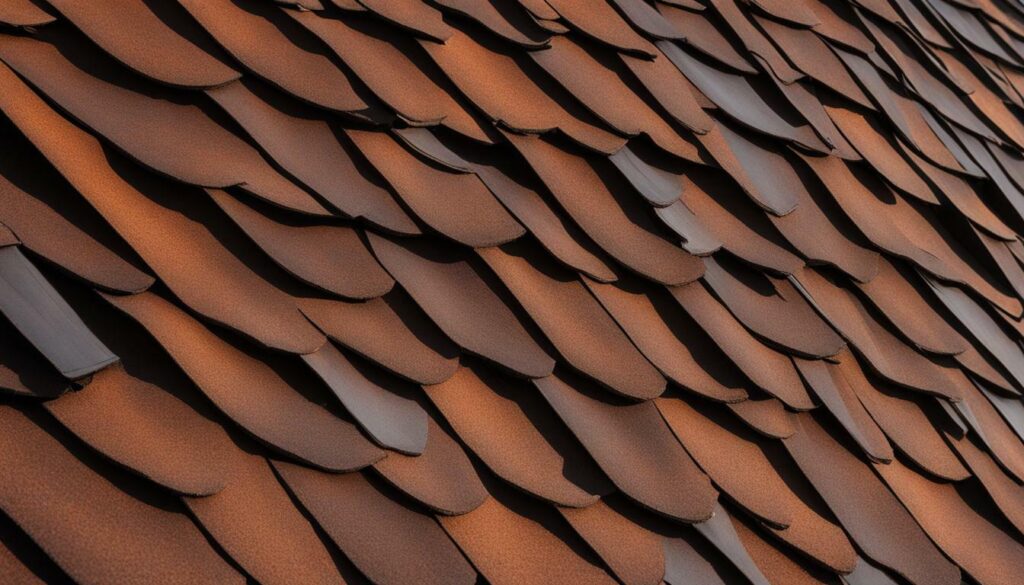
Identifying Visible Roof Damage
Certain visible signs can indicate roof damage, such as water stains in the attic or visible stains and spots on the ceiling. These signs are a clear indication that there is a problem with your roof that needs immediate attention. It is important to address these issues promptly to prevent further damage and potential costly repairs.
One common visible sign of roof damage is water stains in the attic. If you notice any discoloration or dampness on the walls or ceiling of your attic, it could be a result of a leaky roof. Water stains can indicate that water is seeping through the roof and making its way into your home, potentially causing structural damage and mold growth.
Another visible sign of roof damage is the presence of damaged or missing shingles. If you see any shingles that are cracked, curled, or completely missing, it is a clear indication that your roof is compromised. Damaged or missing shingles can expose the underlying layers of your roof to the elements, leading to leaks and further damage.
Visible stains and spots on the ceiling are also indicative of roof damage. If you notice any discoloration, watermarks, or bulging areas on your ceiling, it could be a sign that water is leaking through your roof and causing damage to the interior of your home. It is important to address these issues promptly to prevent further damage to your home’s structure and potential mold growth.
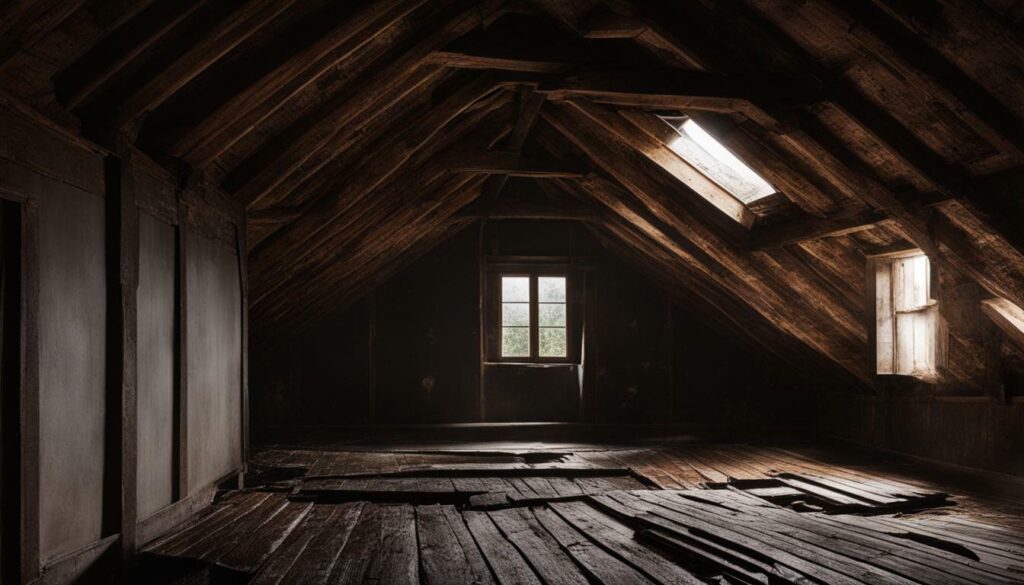
Taking the time to regularly inspect your roof for these visible signs of damage can help you identify issues early on and address them before they worsen. If you are unsure about the condition of your roof or need assistance with repairs or replacements, it is always advisable to seek professional advice. The expertise of a roofing professional can help ensure that your roof remains in good condition, prolonging its lifespan and protecting your home.
Checking the Gutters and Roof Deck
Regularly checking your gutters for a buildup of granules and inspecting the roof deck for any signs of sagging can help identify potential roof issues. Gutters filled with granules can indicate that your shingles are deteriorating, as these granules often shed from them. This is especially common with asphalt shingles and can be a sign that your roof is aging and may require attention. By monitoring your gutters, you can catch this early and address it before it leads to further damage.
The roof deck, which is the foundation of your roof structure, should be examined for any signs of sagging. A sagging roof deck can indicate structural problems, such as rot or damage caused by excessive weight, water infiltration, or poor construction. If you notice any sagging, it is crucial to investigate further and consult a professional to assess the extent of the damage and determine the appropriate course of action.
Regular maintenance and inspections are essential to ensure the longevity of your roof. By taking the time to check your gutters for granule buildup and inspect your roof deck for signs of sagging, you can catch potential issues early on and address them promptly. Remember, prevention is key when it comes to maintaining your roof’s integrity and avoiding costly repairs.
| Signs of a Damaged Roof | Remedial Measures |
|---|---|
| Water stains in the attic, damaged or missing shingles, visible stains and spots on the ceiling | Address any leaks or damage by repairing or replacing the affected areas. |
| Gutters filled with granules, a sagging roof deck | Monitor your gutters, clean them regularly, and consult a professional if you notice excessive granule buildup. Investigate any signs of sagging on the roof deck and seek professional advice. |
| Compromised flashings and seals, problems with valleys, issues with chimneys and skylights | Inspect these components regularly, repair any damage, and ensure proper maintenance to prevent further issues. |
| Ice dams and problems with roof accessories | Take preventive measures, such as installing proper insulation and ensuring the integrity of roof accessories. |
Remember, when it comes to maintaining the health of your roof, prevention and early detection are key. Regular inspections, prompt repairs, and taking preventive measures like trimming overhanging branches and ensuring proper attic insulation can go a long way in extending the lifespan of your roof. If you’re uncertain about the condition of your roof or need professional advice, don’t hesitate to consult a licensed roofing contractor. They can assess your roof’s condition, provide recommendations, and help you make informed decisions to protect your investment.
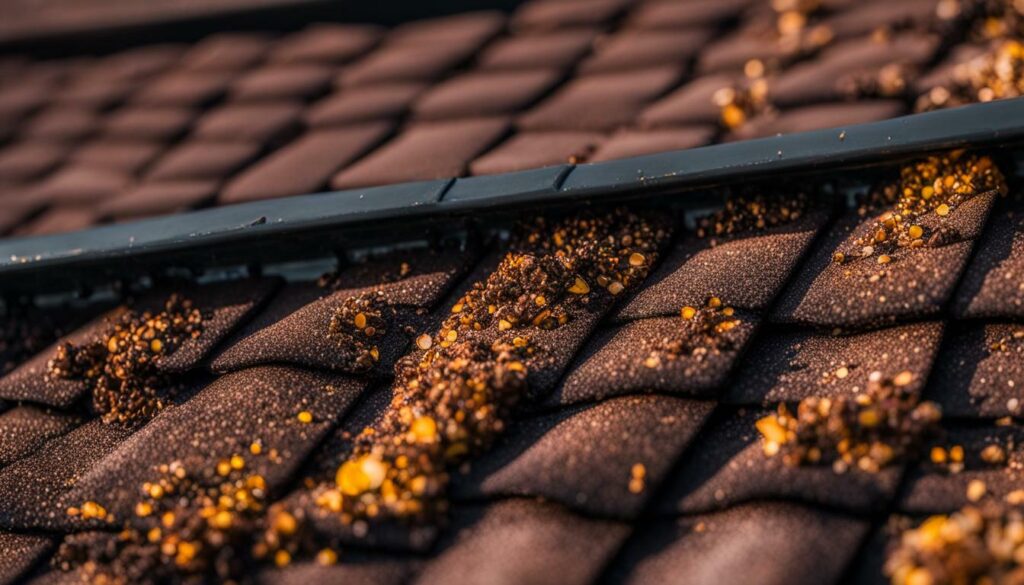
Assessing Flashings, Seals, and Valleys
Flashings, seals, and valleys are critical components of your roof’s structure, and any compromise in these areas can result in leaks and other issues. It is essential to regularly inspect these elements to ensure the integrity of your roof. When assessing flashings, look for signs of wear, such as cracks, rust, or gaps between the flashing and the roof surface. Damaged flashings can allow water to seep into your home, leading to water damage and potential mold growth.
Seals are another crucial aspect to examine. Over time, seals can deteriorate due to exposure to the elements, causing them to lose their effectiveness in preventing water penetration. Check for any signs of sealant deterioration, such as peeling, cracking, or gaps. If you notice any compromised seals, it is important to address them promptly to prevent further damage to your roof.
Valleys, the areas where two roof sections meet, are particularly susceptible to damage. These areas are prone to collecting debris, such as leaves and branches, which can block the flow of water and cause it to pool. Additionally, heavy snow or rainfall can put extra stress on valleys, leading to structural issues. Regularly inspect valleys for any signs of damage, such as misaligned or missing shingles or signs of water infiltration.
To maintain the longevity of your roof, it is crucial to address any compromised flashings, seals, or valleys promptly. If you are unsure about the condition of these elements or need assistance with repairs, it is advisable to seek professional advice. By paying attention to these critical components and taking proactive measures, you can protect your roof from potential damage and ensure the safety of your home.
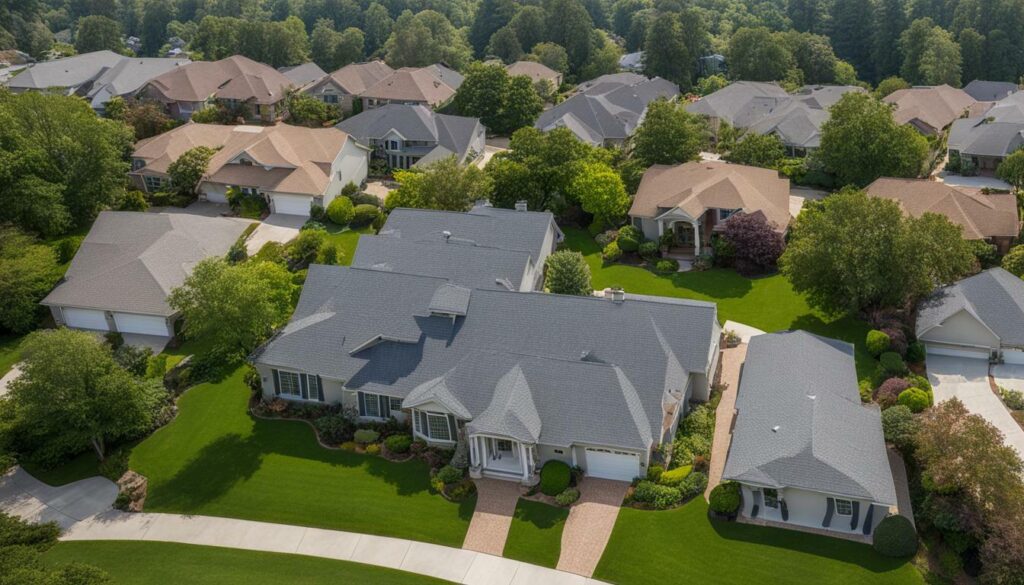
Examining Chimneys, Skylights, and Roof Accessories
Chimneys, skylights, and roof accessories require regular inspections to ensure they are in good condition and not causing any damage to the roof. Issues with chimneys and skylights can lead to leaks and water damage if left untreated, while problems with roof accessories such as vents and satellite dishes can compromise the integrity of the roof. Taking the time to assess these components can help identify potential issues and prevent further damage.
During your inspection, pay close attention to the condition of the chimney and its flashing. Cracked bricks, loose mortar, and damaged flashing can allow water to seep into the structure, leading to leaks and structural damage. Additionally, ensure that the chimney cap is securely in place to prevent birds or debris from entering and causing damage.
Skylights are another potential source of roof problems. Inspect the seals around the skylight to ensure they are intact and not deteriorating. Look for any signs of water damage or leaks around the skylight frame and check that the glass is free from cracks or damage. Addressing any issues promptly can help maintain the integrity of your roof and prevent costly repairs.
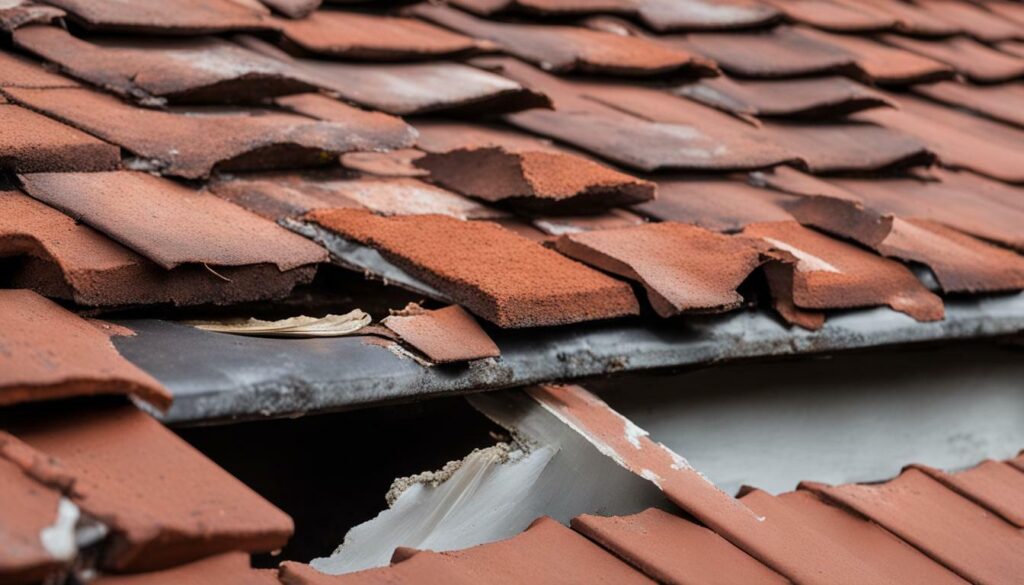
Lastly, roof accessories such as vents, exhaust fans, and satellite dishes should be inspected to ensure they are properly installed and not causing any damage to the roof. Make sure that vents and exhaust fans have intact seals and are not contributing to moisture buildup in the attic. Satellite dishes should be securely mounted and not causing any damage to the roof shingles or underlying structure.
Summary:
- Regular inspections of chimneys, skylights, and roof accessories are essential to prevent roof damage.
- Inspect the chimney and its flashing for any signs of cracks or damage.
- Check the seals around skylights and ensure the glass is free from cracks.
- Inspect roof accessories such as vents and satellite dishes for proper installation and potential damage.
| Signs of Roof Damage | Actions to Take |
|---|---|
| Water stains in the attic | Investigate the source of the leak and address it promptly |
| Visible stains and spots on the ceiling | Contact a roofing professional to assess the extent of the damage and recommend repairs |
| Missing or damaged shingles | Replace the affected shingles to prevent further damage |
| Gutters filled with granules | Clean out the gutters and inspect for any signs of roof deterioration |
Preventing Roof Damage and Extending Lifespan
Taking proactive steps to maintain your roof can significantly extend its lifespan and minimize the risk of damage. Regular roof maintenance is essential to ensure that your roof remains in good condition and can withstand the elements. Here are some key strategies to help prolong the life of your roof:
- Inspect your roof regularly: Conduct a visual inspection of your roof at least once a year, or after severe weather events. Look for any signs of damage, such as missing or damaged shingles, cracks, or gaps in the roof structure. Addressing these issues promptly can prevent further damage.
- Keep your gutters clean: Clogged gutters can cause water to back up onto your roof, leading to water damage and potential leaks. Regularly remove leaves, debris, and granules from your gutters to ensure proper drainage.
- Trim overhanging branches: Overhanging branches can rub against your roof and damage the shingles, as well as provide a pathway for pests to access your home. Trim back any branches that are too close to your roof to prevent potential damage.
- Ensure proper attic insulation: Adequate insulation in your attic can help regulate temperature and prevent heat from escaping, reducing the risk of ice dams forming on your roof during winter. It can also help prevent energy loss, saving you money on heating and cooling bills.
Taking these preventive measures can help prolong the lifespan of your roof and minimize the need for costly repairs or replacement. However, if you’re unsure about the condition of your roof or if you notice any signs of damage, it’s always advisable to seek professional advice. A qualified roofing contractor can assess the condition of your roof, provide necessary repairs, and offer guidance on how to best maintain its longevity.
Remember, when it comes to your roof, prevention is key. By staying proactive and addressing any issues promptly, you can protect your investment and ensure the long-term stability and safety of your home.
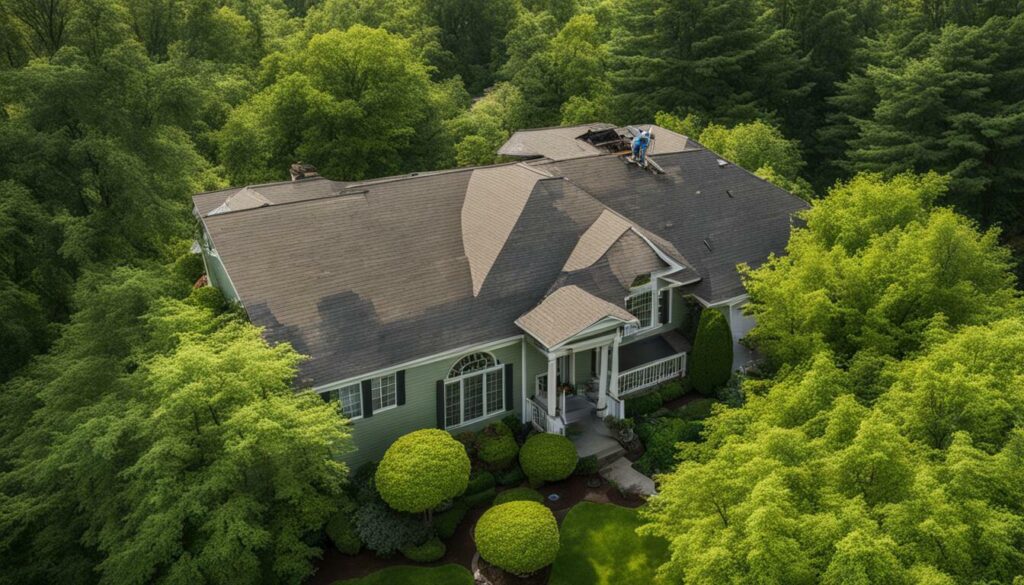
When to Consider Roof Replacement
In some cases, roof damage may be severe enough to warrant a complete roof replacement rather than repairs. While minor issues can often be fixed with repairs, certain signs indicate that a replacement is necessary to ensure the safety and longevity of your home.
One of the key indicators that you may need a roof replacement is if you have multiple missing or damaged shingles. If a significant portion of your roof is compromised, it is more cost-effective and practical to replace the entire roof rather than patching up individual areas.
Another sign that replacement is needed is if your roof is nearing the end of its expected lifespan. Most roofs have a lifespan of around 20 to 25 years, depending on the materials used and the environmental conditions they are exposed to. If your roof is approaching this age or has surpassed it, it is wise to consider a replacement to avoid future problems.
Additionally, if you notice recurring issues such as leaks, water stains, or mold growth despite multiple repairs, it could be an indication of underlying structural damage. In such cases, a roof replacement may be the best solution to address the root cause of these problems and prevent them from recurring.
Remember, before making a decision on whether to repair or replace your roof, it is advisable to consult with a professional roofing contractor who can assess the condition of your roof and provide expert guidance based on your specific circumstances.
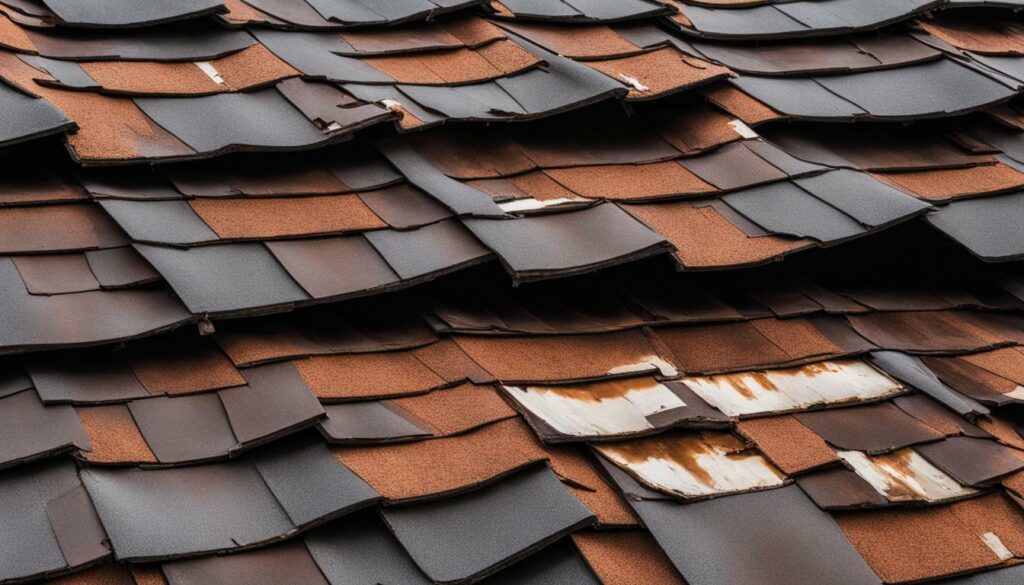
| Signs of Potential Roof Replacement | Indicates the Need for Roof Replacement |
|---|---|
| Multiple missing or damaged shingles | Consider replacing the entire roof instead of repairing |
| Roof approaching or exceeding its expected lifespan | Replacement is wise to avoid future problems |
| Recurring leaks, water stains, or mold growth | Underlying structural damage may require a roof replacement |
Conclusion
By recognizing the signs of a damaged roof early on and taking proactive measures to address them, you can ensure the durability and longevity of your roof, safeguarding your home from potential water damage and costly repairs.
Some common signs to look out for include water stains in the attic, damaged or missing shingles, visible stains and spots on the ceiling, gutters filled with granules, a sagging roof deck, sunlight seeping through the roof, rising energy bills, compromised flashings and seals, problems with valleys, issues with chimneys and skylights, ice dams, and issues with roof accessories. Regular inspections of your roof can help you identify these signs and take prompt action.
In order to prolong the life of your roof, it is important to address these issues promptly. Conducting regular inspections, maintaining your roof’s integrity through timely repairs, and taking preventive measures such as trimming overhanging branches and ensuring proper attic insulation can significantly extend the lifespan of your roof.
If you are uncertain about the condition of your roof or require professional assistance, it is always advisable to seek advice from a qualified roofing contractor. They can provide a comprehensive assessment of your roof’s health and recommend the necessary repairs or replacements to keep your home safe and secure.
FAQ
Q: What are the signs of a damaged roof?
A: Some signs of a damaged roof include water stains in the attic, damaged or missing shingles, visible stains and spots on the ceiling, gutters filled with granules, a sagging roof deck, sunlight seeping through the roof, rising energy bills, compromised flashings and seals, problems with valleys, issues with chimneys and skylights, ice dams, and issues with roof accessories.
Q: How can I prolong the life of my roof?
A: Conduct regular roof inspections, address any issues promptly, and take preventive measures such as trimming overhanging branches and ensuring proper attic insulation. These steps can help prolong the life of your roof.
Q: When should I consider roof replacement?
A: Roof replacement may be necessary when the roof is extensively damaged, is reaching the end of its lifespan, or has recurring issues that cannot be adequately repaired. It is advisable to seek professional advice to determine the best course of action.
